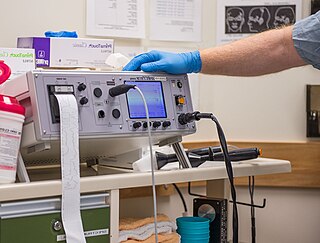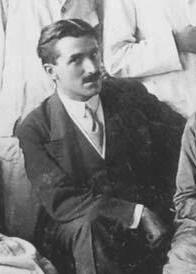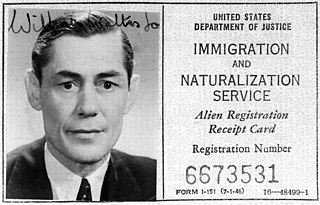
Electroconvulsive therapy (ECT) is a psychiatric treatment where a generalized seizure is electrically induced to manage refractory mental disorders. Typically, 70 to 120 volts are applied externally to the patient's head, resulting in approximately 800 milliamperes of direct current passing between the electrodes, for a duration of 100 milliseconds to 6 seconds, either from temple to temple or from front to back of one side of the head. However, only about 1% of the electrical current crosses the bony skull into the brain because skull impedance is about 100 times higher than skin impedance.
Richard Bentall is a Professor of Clinical Psychology at the University of Sheffield in the UK.
Medical torture describes the involvement of, or sometimes instigation by, medical personnel in acts of torture, either to judge what victims can endure, to apply treatments which will enhance torture, or as torturers in their own right. Medical torture overlaps with medical interrogation if it involves the use of professional medical expertise to facilitate interrogation or corporal punishment, in the conduct of torturous human experimentation or in providing professional medical sanction and approval for the torture of prisoners. Medical torture also covers torturous scientific experimentation upon unwilling human subjects.

Ugo Cerletti was an Italian neurologist who discovered the method of electroconvulsive therapy (ECT) used in psychiatry. Electroconvulsive therapy is a therapy in which electric current is used to provoke a seizure for a short duration. This therapy is used in an attempt to treat certain mental disorders, and may be useful when other possible treatments have not, or cannot, cure the person of their mental disorder.
Ladislas Joseph Meduna, a Hungarian neuropathologist and neuropsychiatrist, initiated convulsive treatment, the repeated induction of grand mal seizures in the treatment for psychosis. Observing the high concentration of glia in post-mortem brains of patients with epilepsy and a paucity in those with schizophrenia, he proposed that schizophrenia might be treated by inducing "epileptic" seizures. Thus, chemically induced seizures became the electroconvulsive therapy that is now in worldwide use.
Peter Roger Breggin is an American psychiatrist and critic of shock treatment and psychiatric medication and COVID-19 response. In his books, he advocates replacing psychiatry's use of drugs and electroconvulsive therapy with psychotherapy, education, empathy, love, and broader human services.

William Walters Sargant was a British psychiatrist who is remembered for the evangelical zeal with which he promoted treatments such as psychosurgery, deep sleep treatment, electroconvulsive therapy and insulin shock therapy.
Psychic driving was a psychiatric procedure of the 1950s and 1960s in which patients were subjected to a continuously repeated audio message on a looped tape to alter their behaviour. In psychic driving, patients were often exposed to hundreds of thousands of repetitions of a single statement over the course of their treatment. They were also concurrently administered muscular paralytic drugs such as curare to subdue them for the purposes of exposure to the looped message(s). The procedure was pioneered by Dr. D. Ewen Cameron, and used and funded by the CIA's Project MKUltra program in Canada.

Insulin shock therapy or insulin coma therapy was a form of psychiatric treatment in which patients were repeatedly injected with large doses of insulin in order to produce daily comas over several weeks. It was introduced in 1927 by Austrian-American psychiatrist Manfred Sakel and used extensively in the 1940s and 1950s, mainly for schizophrenia, before falling out of favour and being replaced by neuroleptic drugs in the 1960s.
Deep sleep therapy (DST), also called prolonged sleep treatment or continuous narcosis, is a discredited form of ostensibly psychiatric treatment in which drugs are used to keep patients unconscious for a period of days or weeks. The controversial practice led to the death of 25 patients in Chelmsford Private Hospital in New South Wales, Australia, from the early 1960s to late 1970s.

Oregon State Hospital is a public psychiatric hospital in the U.S. state of Oregon, located in the state's capital city of Salem with a smaller satellite campus in Junction City opened in 2014. Founded in 1862 and constructed in the Kirkbride Plan design in 1883, it is the oldest operating psychiatric hospital in the state of Oregon, and one of the oldest continuously operated hospitals on the West Coast.
Electroconvulsive therapy is a controversial psychiatric treatment in which seizures are induced with electricity. ECT was first used in the United Kingdom in 1939 and, although its use has been declining for several decades, it was still given to about 11,000 people a year in the early 2000s.
Maximilian Fink is an American neurologist and psychiatrist best known for his work on ECT. His early work also included studies on the effect of psychoactive drugs on brain electrical activity; more recently he has written about the syndromes of catatonia and melancholia.
Linda Andre is an American psychiatric survivor activist and writer, living in New York City, who is the director of the Committee for Truth in Psychiatry (CTIP), an organization founded by Marilyn Rice in 1984 to encourage the U.S. Food and Drug Administration (FDA) to regulate electroconvulsive therapy (ECT) machines.
Leonard Roy Frank was an American human rights activist, psychiatric survivor, editor, writer, aphorist, and lecturer.
Ted Chabasinski is an American psychiatric survivor, human rights activist and attorney who lives in Berkeley, California. At the age of six, he was taken from his foster family's home and committed to a New York psychiatric facility. Diagnosed with childhood schizophrenia, he underwent intensive electroshock therapy and remained an inmate in a state psychiatric hospital until the age of seventeen. He subsequently trained as a lawyer and became active in the psychiatric survivors movement. In 1982, he was a leader in an initially successful campaign seeking to ban the use of electroshock in Berkeley, California.
Yang Yongxin is a highly controversial Chinese clinical psychiatrist who advocated and practiced electroconvulsive therapy (ECT) without anaesthesia or muscle relaxants as a cure for alleged video game and Internet addiction in adolescents. Yang is currently deputy chief of the Fourth Hospital of Linyi, in the Shandong province of China. He runs the Internet Addiction Treatment Center at the hospital.

Dr. Omar Fakhri - الدكتور عمر فخري – B.Sc., M.Sc., Ph.D. FRCPath is a medical scientist who is best known for his research in several areas: the role of vitamin K in treating hemorrhagic diathesis in children, the cooperation between antibodies and lymphocytes and their role in immune response, the use of peritoneal macrophages in the treatment of resistant infections in leukemia patients, the effect of electroconvulsive therapy on diabetes and the use of low voltage electrotherapy in the treatment of resistant skin burns, psoriasis, exophthalmos, aplastic anaemia and other diseases.

David John Impastato, M.D. – born January 8, 1903, died February 28, 1986 – was a neuropsychiatrist who pioneered the use of electroconvulsive therapy (ECT) in the United States. A treatment for mental illness initially called "electroshock," ECT was developed in 1937 by Dr. Ugo Cerletti and Lucio Bini, working in Rome. Impastato has been credited with the earliest documented use of the revolutionary method in North America, administered in early 1940 to a schizophrenic female patient in New York City. Soon after, he and colleague Dr. Renato Almansi completed the first case study of ECT to appear in a U.S. publication. Impastato spent the next four decades refining the technique, gaining recognition as one of its most authoritative spokesmen. He taught, lectured widely and published over fifty articles on his work. He called on ECT practitioners to observe the strictest protocols of patient safety, countered resistance to ECT from both the medical and cultural establishments, and met later challenges to electroconvulsive therapy from developments in psychopharmacology. Impastato would live to see ECT recommended by the American Psychiatric Association for a distinct core of intractable mental disorders. The U.S. Food and Drug Administration took longer to respond to the treatment's potential. But in 2016 the FDA drafted guidelines for ECT similar to those of the APA, as well as proposing regulations for treatment with Class II and Class III devices. Though still not free of controversy, electroconvulsive therapy is the treatment of choice for an estimated 100,000 patients a year in the United States.
Electroconvulsive therapy (ECT) is a controversial therapy used to treat certain mental illnesses such as major depressive disorder, schizophrenia, depressed bipolar disorder, manic excitement, and catatonia. These disorders are difficult to live with and often very difficult to treat, leaving individuals suffering for long periods of time. In general, ECT is not looked at as a first line approach to treating a mental disorder, but rather a last resort treatment when medications such as antidepressants are not helpful in reducing the clinical manifestations.






